Chicago Electric 68887 User Manual
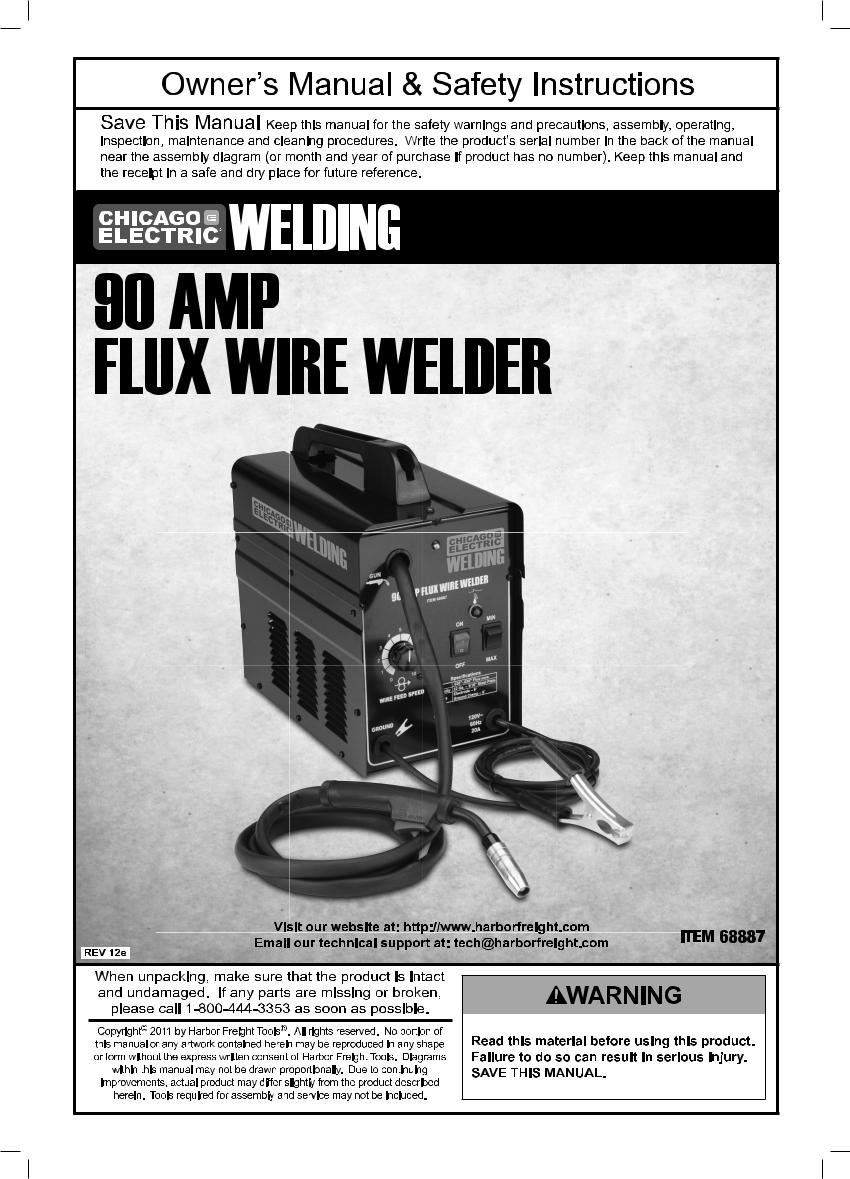
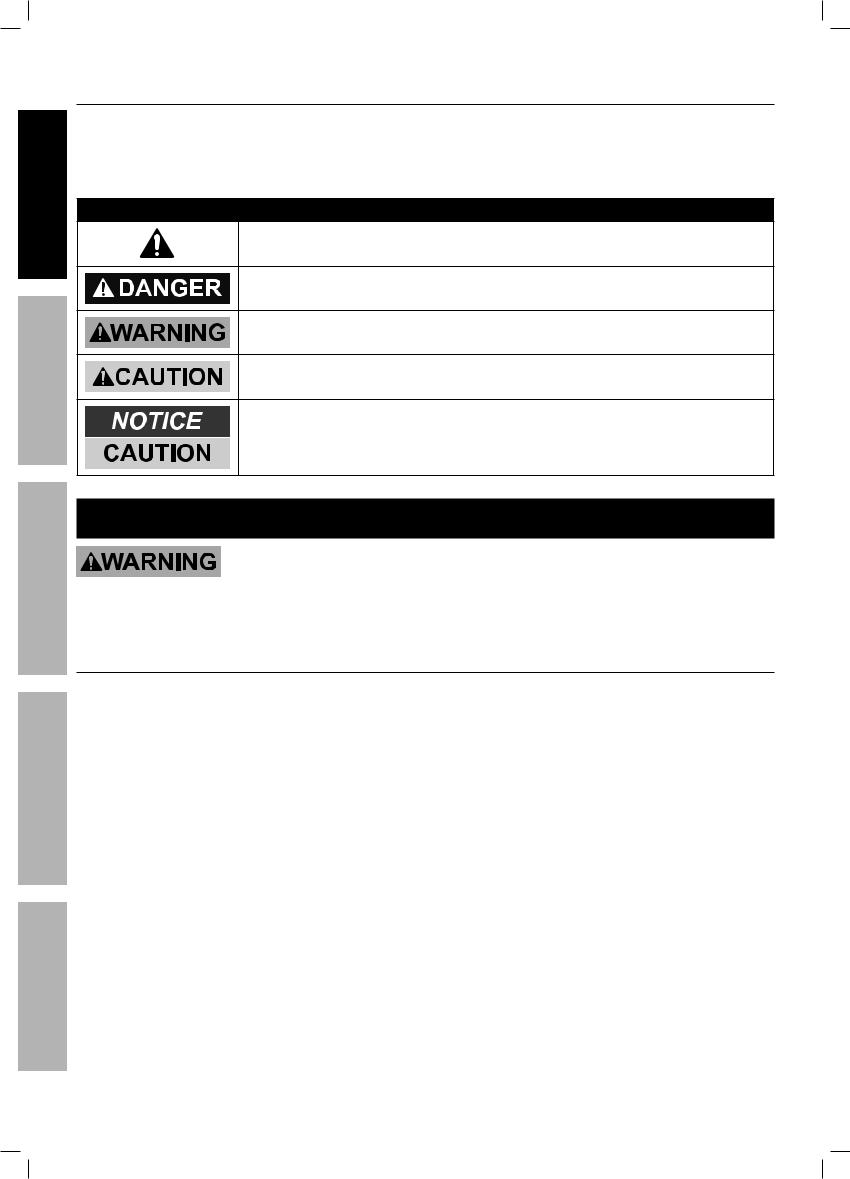
SAFETY
SETUP
WELDING BASIC
TIPS WELDING
MAINTENANCE
Table of Contents
Safety.......................................................... |
2 |
Welding Tips............................................... |
18 |
Specifications.............................................. |
7 |
Maintenance............................................... |
22 |
Setup........................................................... |
7 |
Parts Lists and Diagrams........................... |
26 |
Basic Welding............................................ |
12 |
Warranty..................................................... |
28 |
WARNING SYMBOLS AND DEFINITIONS
This is the safety alert symbol. It is used to alert you to potential personal injury hazards. Obey all safety messages that follow this symbol to avoid possible injury or death.
Indicates a hazardous situation which, if not avoided, will result in death or serious injury.
Indicates a hazardous situation which, if not avoided, could result in death or serious injury.
Indicates a hazardous situation which, if not avoided, could result in minor or moderate injury.
Addresses practices not related to personal injury.
IMPORTANT SAFETY INFORMATION
Read all safety warnings and instructions.
Failure to follow the warnings and instructions may result in electric shock, fire and/or serious injury.
Save all warnings and instructions for future reference.
General Safety
PROTECT yourself and others. Read and understand this information.
1.Before use, read and understand manufacturer′s instructions, Material Safety Data Sheets (MSDS′s),
employer′s safety practices, and ANSI Z49.1.
2.Keep out of reach of children.
Keep children and bystanders away while operating.
3.Place the welder on a stable location before use.
If it falls while plugged in, severe injury, electric shock, or fire may result.
4.Do not overreach.
Keep proper footing and balance at all times.
5.Stay alert, watch what you are doing and use common sense when operating a welder.
Do not use a welder while you are tired or under the influence of drugs, alcohol or medication.
A moment of inattention while operating welders may result in serious personal injury.
6.Avoid unintentional starting. Make sure you are prepared to begin work before turning on the Welder.
7.Never leave the Welder unattended while energized. Turn power off if you have to leave.
8.The warnings, precautions, and instructions discussed in this instruction manual cannot cover all possible conditions and situations that may occur. It must be understood by the operator that common sense and caution are factors which cannot be built into this product, but must be supplied by the operator.
9.This product, when used for welding and similar applications, contains or produces a chemical known to the State of California to cause cancer and birth defects (or other reproductive harm).
(California Health & Safety Code § 25249.5, et seq.)
10.Handling the cord on this product will expose you to lead, a chemical known to the State of California to cause cancer, and birth defects or other reproductive harm.
Wash hands after handling.
(California Health & Safety Code § 25249.5, et seq.)
Page 2 |
For technical questions, please call 1-800-444-3353. |
SKU 68887 |

Fume and Gas Safety
FUMES AND GASES can be hazardous to your health.
1.Exposure to welding or cutting exhaust fumes can increase the risk of developing certain cancers, such as cancer of the larynx and lung cancer.
Also, some diseases that may be linked to exposure to welding or cutting exhaust fumes are:
• Early onset of Parkinson’s Disease
• Heart disease |
• Ulcers |
4.Use enough ventilation, exhaust at arc, or both, to keep fumes and gases from breathing zone and general area. If engineering controls are not feasible, use an approved respirator.
5.Work in a confined area only if it is well-ventilated, or while wearing an air-supplied respirator.
•Damage to the reproductive organs
•Inflammation of the small intestine or
stomach |
• Kidney damage |
• Respiratory diseases such as emphysema, bronchitis, or pneumonia
2.Do not use near degreasing or painting operations.
3.Keep head out of fumes.
Do not breathe exhaust fumes.
6.Have a recognized specialist in
Industrial Hygiene or Environmental Services check the operation and air quality
and make recommendations
for the specific welding situation.
Follow OSHA guidelines for
Permissible Exposure Limits (PEL’s) and the American Conference of Governmental Industrial Hygienists recommendations for
Threshold Limit Values (TLV’s) for fumes and gases.
Arc Ray Safety
ARC RAYS can injure eyes and burn skin.
1.Wear ANSI-approved welding eye protection featuring at least a number 10 shade lens rating.
2.Wear leather leggings, fire resistant shoes or boots during use. Do not wear pants with cuffs, shirts with open pockets, or any clothing that can catch and hold molten metal or sparks.
3.Keep clothing free of grease, oil, solvents, or any flammable substances.
Wear dry, insulating gloves and protective clothing.
4.Wear an approved head covering to protect the head and neck. Use aprons, cape, sleeves, shoulder covers, and bibs designed and approved for welding and cutting procedures.
5.When welding/cutting overhead or in confined spaces, wear flame resistant ear plugs or
ear muffs to keep sparks out of ears.
SKU 68887 |
For technical questions, please call 1-800-444-3353. |
Page 3 |
SAFETY
SETUP
BASIC WELDING
WELDING TIPS
MAINTENANCE
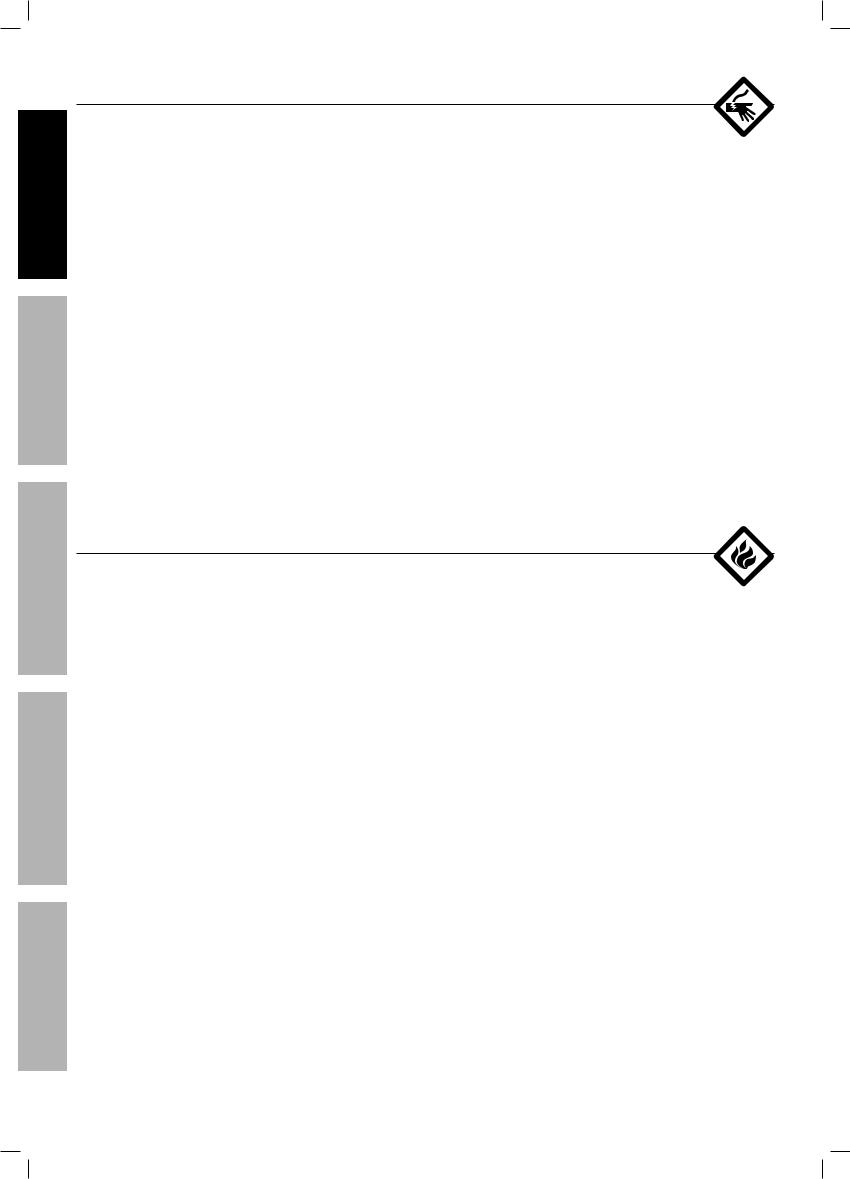
SAFETY
SETUP
Electrical Safety
ELECTRIC SHOCK can KILL.
1.Turn off, disconnect power, and
discharge electrode to ground before setting down torch/electrode holder and before service.
2.Do not touch energized electrical parts.
Wear dry, insulating gloves. Do not touch electrode holder, electrode, welding torch, or welding wire with bare hand. Do not wear wet or damaged gloves.
3.Connect to grounded, GFCI protected power supply only.
4.Do not use near water or damp objects.
5.People with pacemakers should consult their physician(s) before use. Electromagnetic fields in close proximity to heart pacemaker could cause pacemaker interference or pacemaker failure.
6.Do not expose welders to rain or wet conditions.
Water entering a welder will increase the risk of electric shock.
7.Do not abuse the cord. Never use the cord for carrying, pulling or unplugging the welder. Keep cord away from heat, oil, sharp edges or moving parts. Damaged or entangled
cords increase the risk of electric shock.
8.Do not use outdoors.
9.Insulate yourself from the workpiece and ground.
Use nonflammable, dry insulating material if possible, or use dry rubber mats, dry wood or plywood, or other dry insulating material large enough to cover your full area of contact with the work or ground.
10.Use care not to touch the welding tip to grounded material whenever the unit is plugged in. Electric shock, fire, or burns may happen if appropriate precautions are not taken.
WELDING BASIC
TIPS WELDING
MAINTENANCE
Fire Safety
ARC AND HOT SLAG can cause fire.
1.Clear away or protect flammable objects.
Remove or make safe all combustible materials for a radius of 35 feet (10 meters) around the work area. Use a fire resistant material to cover or block all open doorways, windows, cracks, and other openings.
2.Keep ABC-type fire extinguisher near work area and know how to use it.
3.Maintain a safe working environment.
Keep the work area well lit.
Make sure there is adequate surrounding workspace. Keep the work area free of obstructions,
grease, oil, trash, and other debris.
4.Do not operate welders in atmospheres containing dangerously reactive or flammable liquids, gases, vapors, or dust.
Provide adequate ventilation in work areas to prevent accumulation of such substances.
Welders create sparks which may ignite flammable substances or make reactive fumes toxic.
5.If working on a metal wall, ceiling, etc., prevent ignition of combustibles on the other side by moving the combustibles to a safe location. If relocation of combustibles is not possible, designate someone to serve as a fire watch, equipped with a fire extinguisher, during the cutting process and for at least one half hour after the cutting is completed.
6.Do not weld or cut on materials having a combustible coating or combustible
internal structure, as in walls or ceilings, without an approved method for eliminating the hazard.
7.Do not dispose of hot slag in containers holding combustible materials.
8.After welding, make a thorough examination for evidence of fire. Be aware that easily visible smoke or flame may not be present
for some time after the fire has started.
9.Do not apply heat to a container that has held an unknown substance or a combustible material whose contents, when heated,
can produce flammable or explosive vapors.
Clean and purge containers before applying heat. Vent closed containers, including castings, before preheating, welding, or cutting.
Page 4 |
For technical questions, please call 1-800-444-3353. |
SKU 68887 |

Welder use and care
1.Do not use the welder if the switch does not turn it on and off. Any welder that cannot be controlled with the switch is dangerous and must be repaired.
2.Disconnect the plug from the power source before making any adjustments, changing accessories, or storing welders.
Such preventive safety measures reduce the risk of starting the welder accidentally.
3.Prevent unintentional starting.
Ensure the switch is in the off-position before connecting to power source or moving
the welder. Carrying or energizing welders that have the switch on invites accidents.
4.Store idle welders out of the reach of children and do not allow persons unfamiliar with the welder or these instructions to operate the welder. Welders are dangerous in the hands of untrained users.
5.Use the welder and accessories in accordance with these instructions, taking into account the working conditions and the work to be performed.
Use of the welder for operations different from those intended could result in a hazardous situation.
SAFETY
SETUP
Maintenance
1.Maintain welders. Check for misalignment or binding of moving parts, breakage of parts and any other condition that may affect the welder’s operation. If damaged, have the welder repaired before use. Many accidents are caused by poorly maintained welders.
2.Have your welder serviced by a qualified repair person using only identical replacement parts. This will ensure that the safety of the welder is maintained.
3.Maintain labels and nameplates on the Welder.
These carry important information. If unreadable or missing, contact
Harbor Freight Tools for a replacement.
4.Unplug before maintenance. Unplug the Welder from its electrical outlet before any inspection, maintenance, or cleaning procedures.
 SAVE THESE INSTRUCTIONS.
SAVE THESE INSTRUCTIONS.
SKU 68887 |
For technical questions, please call 1-800-444-3353. |
Page 5 |
BASIC WELDING
WELDING TIPS
MAINTENANCE
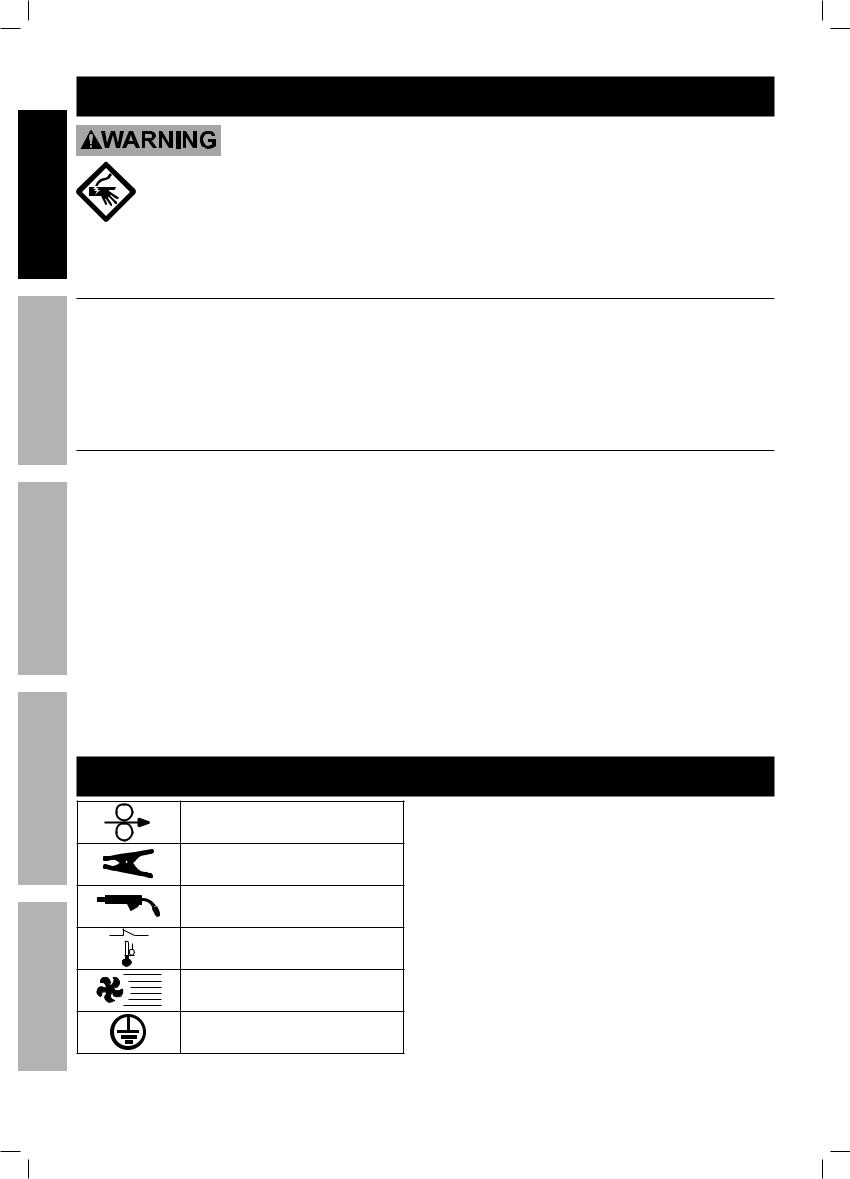
SAFETY
SETUP
WELDING BASIC
TIPS WELDING
MAINTENANCE
Grounding
TO PREVENT ELECTRIC SHOCK AND DEATH FROM INCORRECT GROUNDING WIRE CONNECTION:
Check with a qualified electrician if you are in doubt as to whether the outlet is properly grounded. Have a plug installed by a certified electrician. Do not use the Welder if the power cord or plug is damaged. If damaged, have it repaired by a service facility before use. If the plug will not fit the
outlet, have a proper outlet installed by a qualified electrician.
Grounded Welders
1. The grounding prong in the plug is connected |
2. The Welder must be plugged into an appropriate |
through the green wire inside the cord to the |
outlet, properly installed and grounded in |
grounding system in the Welder. The green wire |
accordance with all codes and ordinances. |
in the cord must be the only wire connected to |
|
the Welder’s grounding system and must never |
|
be attached to an electrically “live” terminal. |
|
Extension Cords |
|
1.If an extension cord is used, it must have the following wire size: up to 30 feet, use 10 AWG size wire; 30 to 50 feet, use 8 AWG wire; Over 50 feet, use 6 AWG wire.
2.As the distance from the supply outlet increases, you must use a heavier gauge extension cord. Using extension cords with inadequately sized wire causes a serious drop in voltage, resulting in loss of power and possible welder damage.
3.The smaller the gauge number of the wire, the greater the capacity of the cord. For example, a 14 gauge cord can carry a higher current than a 16 gauge cord.
4.When using more than one extension cord to make up the total length, make sure each cord contains at least the minimum wire size required.
5.If you are using one extension cord for more than one welder, add the nameplate amperes and use the sum to determine the required minimum cord size.
6.If you are using an extension cord outdoors, make sure it is marked with the suffix “W-A” (“W” in Canada) to indicate it is acceptable for outdoor use.
7.Make sure the extension cord is properly wired and in good electrical condition. Always replace a damaged extension cord or have it repaired by a qualified electrician before using it.
8.Protect the extension cords from sharp objects, excessive heat, and damp or wet areas.
Symbology
Wire Feed (Speed)
Workpiece Ground Cable
Gun Cable
Overheat Shutdown Indicator
Cooling Fan
Housing Ground Point
V~ |
Volts Alternating Current |
A |
Amperes |
|
|
|
|
OCV |
Open Circuit Voltage |
KVA |
Kilovolt Amperes |
(Volts / 1000 * Amperes) |
|
IPM |
Inches Per Minute |
AWG |
American Wire Gauge |
Page 6 |
For technical questions, please call 1-800-444-3353. |
SKU 68887 |

Specifications
Electrical Rating |
120V~ / 20A |
|
Welding Output |
60 ~ 120 A, AC |
|
Capacity |
18 gauge (0.048″) to 3/16″ (0.19″) mild steel only |
|
Not for welding aluminum or stainless steel |
||
|
||
Duty Cycle |
20% @ 90A |
|
(See explanation on page 14) |
||
|
||
Open Circuit Voltage |
27 |
|
KVA |
2.38 |
|
Welder Tips / Wire Size |
Installed tip will accept .030″ to .035″ FLUX CORE wire |
|
Wire Spool Capacity |
4″ diameter / 2 lb. spool |
Setup
Read the ENTIRE IMPORTANT SAFETY INFORMATION section at the beginning of this manual including all text under subheadings therein before set up or use of this product.
TO PREVENT SERIOUS INJURY FROM ACCIDENTAL OPERATION:
Turn the Power Switch off and unplug the welder before assembly.
Cover Assembly
SAFETY
SETUP
BASIC WELDING
1.Slide the Handle into the slot on the Cover from the back.
2.The notch on the front of the Handle should drop into the slot in the Cover. Both ends of the Handle should lay flush against the top of the Cover.
3.Secure with Screw at front of unit.
notch drops
into slot on Handle Cover here
Cover
 Screw
Screw
WELDING TIPS
MAINTENANCE
SKU 68887 |
For technical questions, please call 1-800-444-3353. |
Page 7 |
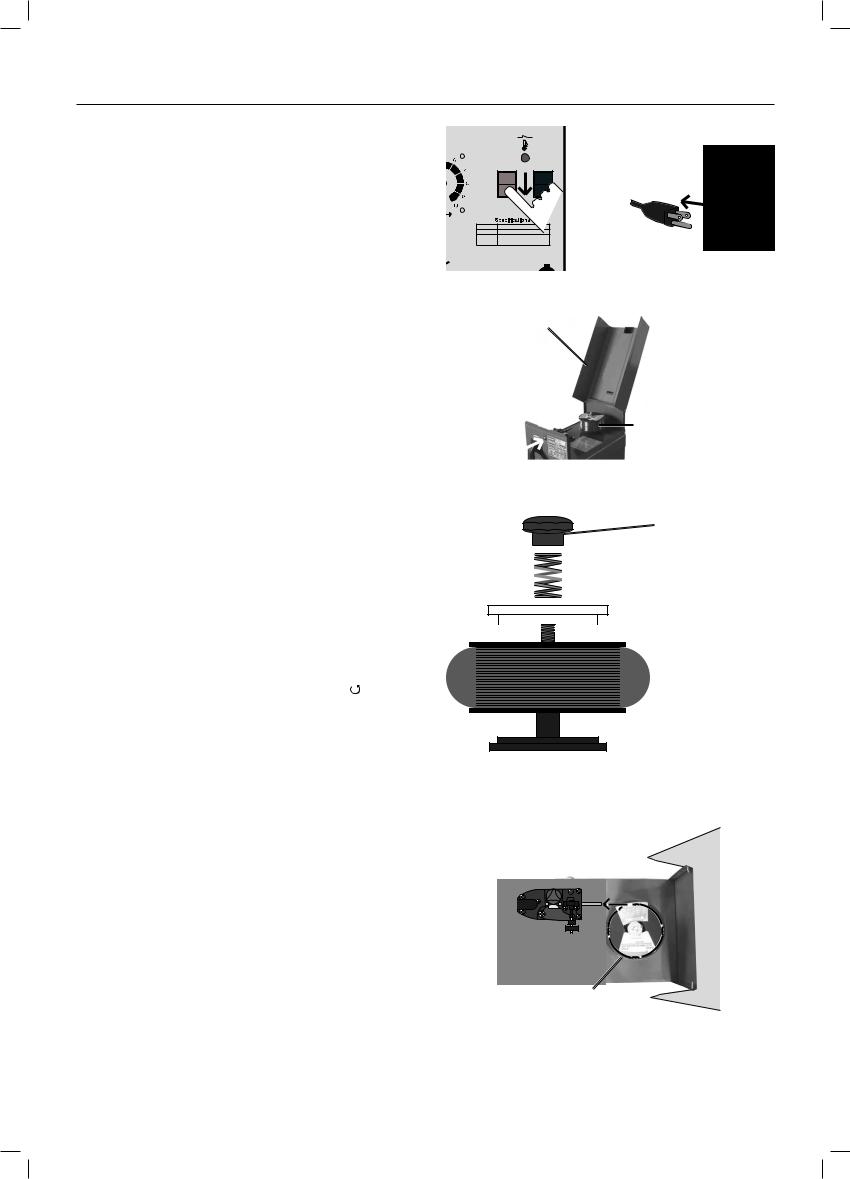
Wire Spool Installation
SAFETY |
1. |
Turn the Welder to OFF and unplug |
|
it before proceeding. |
|
|
|
|
|
|
|
|
|
|
SETUP |
2. |
the control panel and open the cover. |
|
Press in the pin at the top center of |
|
|
|
|
|
|
|
BASIC |
3. |
Remove the Knob, Spring and the Top Plate. |
|
||
WELDING |
|
If replacing a Spool, remove the old Spool |
|
and all remaining wire from the liners. |
|
|
|
|
|
4. |
Place the new flux core Wire Spool |
|
|
over the Spool Spindle. |
|
|
To prevent wire feed problems, set the Spool |
|
|
|
|
|
so that it will unwind counterclockwise . |
WELDING |
|
|
|
|
|
TIPS |
5. |
Replace the Top Plate (turned as shown in |
|
||
|
|
illustration), the Spring and the Knob. |
|
|
|
|
|
|
MAINTENANCE |
|
|
|
|
|
|
ITEM 68887 |
|
|
|
|
ON |
MIN |
D SPEED |
Wire |
. |
|
|
Capacity |
XX |
|
|
Cables |
Electrode – X′ |
|
|
Ground Clamp – X′ |
|
|
|
|
120V~ |
|
Cover
Wire
Spool
Knob

 Spring
Spring
 Top Plate
Top Plate
 Wire Spool
Wire Spool
 Spindle
Spindle
wire must unwind this direction
Page 8 |
For technical questions, please call 1-800-444-3353. |
SKU 68887 |
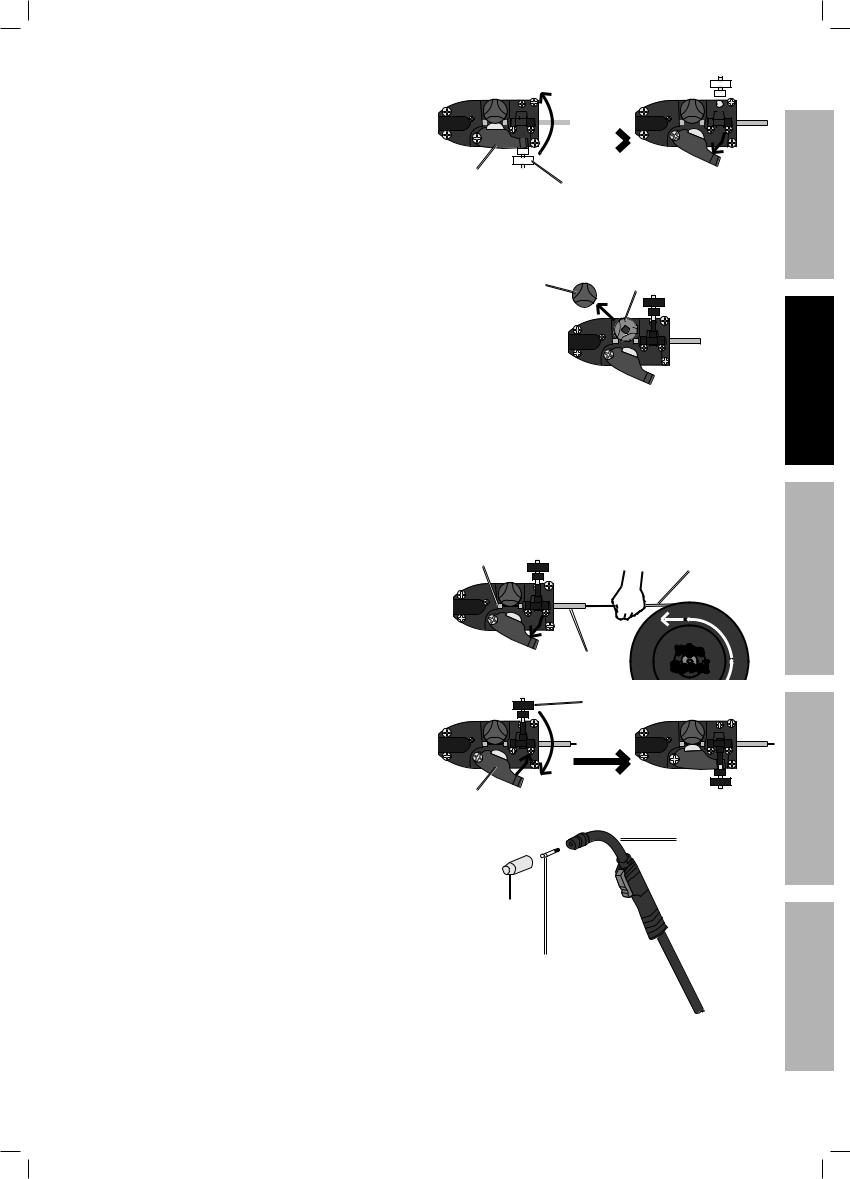
6.Turn the Feed Tensioner counterclockwise  to loosen it enough to pull it up, releasing tension. Swing the Feed Swing Arm out. (Note: Do
to loosen it enough to pull it up, releasing tension. Swing the Feed Swing Arm out. (Note: Do
not loosen the Feed Tensioner too much, or it will come apart.)
7.Loosen and remove the Feed Knob. Compare the wire diameter marked on the Wire Spool with the stamped number on the top of the Feed Roller. The Roller’s groove size must be compatible with the wire diameter -
.8mm rollers also work with .030″ wire &
.9mm rollers also work with .035″ wire.
Flip the Feed Roller as needed and confirm that the number facing up is the same as the wire diameter on the Spool.
Replace and secure the Feed Knob.
|
|
|
|
|
|
|
|
|
|
|
|
|
|
|
|
|
|
|
|
|
|
|
|
|
|
|
|
|
|
|
|
|
|
|
|
|
|
|
|
|
|
|
|
|
|
|
|
|
|
|
|
|
|
|
|
|
|
|
|
|
|
|
|
|
|
|
|
|
|
|
|
|
|
|
|
|
|
|
|
|
|
|
|
|
|
|
|
|
|
|
|
|
|
|
|
|
|
|
|
|
|
|
|
|
|
|
|
|
|
|
|
|
|
|
|
|
|
|
|
|
|
|
|
|
|
|
|
|
|
|
|
|
|
|
|
|
|
|
|
|
|
|
|
|
|
|
|
|
|
|
|
|
|
|
|
|
|
|
|
|
|
|
|
|
|
|
|
|
|
|
|
|
|
|
|
|
|
|
|
|
|
|
|
|
|
|
|
|
|
|
|
|
|
|
|
|
|
|
|
|
|
|
|
|
|
|
|
|
|
|
|
|
|
|
|
|
|
|
|
|
|
|
|
|
|
|
|
|
|
|
|
|
|
|
|
|
|
|
|
|
|
|
|
|
|
|
|
|
|
|
|
Feed Swing |
|
|
Feed |
|
|||||||||||||
|
|
|
|||||||||||||||
Arm |
|
|
Tensioner |
|
|||||||||||||
Feed |
Feed |
Knob |
Roller |
|
. |
|
030″ |
IMPORTANT:
Securely hold onto the end of the welding wire and keep tension on it during the following steps.
If this is not done, the welding wire will unravel and create a tangled “bird’s nest”, wasting wire.
8.Cut off all bent and crimped wire.
Make sure that the cut end has no burrs or sharp edges; cut again if needed.
9.Keep tension on the wire and guide at least 12 inches of wire into the Wire Liners.
10.Swing the Feed Swing Arm closed, and swing the Feed Tensioner across the tip of the Arm, to latch it. Make sure the Welding Wire is resting in the top groove of the Feed Roller, then turn the
Feed Tensioner clockwise  a couple of turns. After the wire is held by the Feed
a couple of turns. After the wire is held by the Feed
Tensioner, you may release it.
11.Pull the Nozzle to remove it.
12.Using the third oval hole on the Multi-wrench, turn the Contact Tip counterclockwise  and remove.
and remove.
13.Lay the Gun Cable out in a straight line so that the wire moves through it easily. Leave the cover open, so that the feed mechanism can be observed.
Wire |
HOLD WIRE |
|
Liner |
SECURELY welding |
|
|
|
wire |
|
leader |
Wire |
|
Spool |
|
|
wire liner |
|
|
|
|
|
Feed |
|
|
Tensioner |
|
Feed Swing
Arm
Gun
Nozzle
Contact
Tip
SKU 68887 |
For technical questions, please call 1-800-444-3353. |
Page 9 |
SAFETY
SETUP
BASIC WELDING
WELDING TIPS
MAINTENANCE
